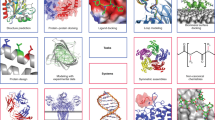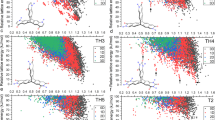Abstract
We describe Scaffold Hunter, a highly interactive computer-based tool for navigation in chemical space that fosters intuitive recognition of complex structural relationships associated with bioactivity. The program reads compound structures and bioactivity data, generates compound scaffolds, correlates them in a hierarchical tree-like arrangement, and annotates them with bioactivity. Brachiation along tree branches from structurally complex to simple scaffolds allows identification of new ligand types. We provide proof of concept for pyruvate kinase.
This is a preview of subscription content, access via your institution
Access options
Subscribe to this journal
Receive 12 print issues and online access
$259.00 per year
only $21.58 per issue
Buy this article
- Purchase on Springer Link
- Instant access to full article PDF
Prices may be subject to local taxes which are calculated during checkout


Similar content being viewed by others
Change history
18 August 2009
In the version of this article initially published, reference 10 was incorrect. The correct reference is: Olah, M. et al. in Chemical Biology: from Small Molecules to Systems Biology and Drug Design (eds. Schreiber, S.L., Kapoor, T.M. & Wess, G.) 760–786 (Wiley-VCH, Weinheim, Germany, 2007). The error has been corrected in the HTML and PDF versions of the article.
References
Roberts, G., Myatt, G.J., Johnson, W.P., Cross, K.P. & Blower, P.E. Jr. J. Chem. Inf. Comput. Sci. 40, 1302–1314 (2000).
Oprea, T.I. & Gottfries, J. J. Comb. Chem. 3, 157–166 (2001).
Larsson, J., Gottfries, J., Bohlin, L. & Backlund, A. J. Nat. Prod. 68, 985–991 (2005).
Larsson, J., Gottfries, J., Muresan, S. & Backlund, A. J. Nat. Prod. 70, 789–794 (2007).
Paolini, G.V., Shapland, R.H.B., van Hoorn, W.P., Mason, J.S. & Hopkins, A.L. Nat. Biotechnol. 24, 805–815 (2006).
Bemis, G.W. & Murcko, M.A. J. Med. Chem. 39, 2887–2893 (1996).
Schuffenhauer, A. et al. J. Chem. Inf. Model. 47, 47–58 (2007).
Koch, M.A. et al. Proc. Natl. Acad. Sci. USA 102, 17272–17277 (2005).
Nören-Müller, A. et al. Proc. Natl. Acad. Sci. USA 103, 10606–10611 (2006).
Olah, M. et al. Chemical Biology: from Small Molecules to Systems Biology and Drug Design (eds. Schreiber, S.L., Kapoor, T.M. & Wess, G.) 760–786 (Wiley-VCH, Weinheim, Germany, 2007).
Inglese, J. et al. Proc. Natl. Acad. Sci. USA 103, 11473–11478 (2006).
Schulz, W. Chem. Eng. News 74, 43–44 (1996).
Lipinski, C.A., Lombardo, F., Dominy, B.W. & Feeney, P.J. Adv. Drug Deliv. Rev. 46, 3–26 (2001).
Verheij, H.J. Mol. Divers. 10, 377–388 (2006).
Reynolds, C.H., Tounge, B.A. & Bembenek, S.D. J. Med. Chem. 51, 2432–2438 (2008).
Acknowledgements
We thank the members of the project group PG504—namely A.B. Ahmed, A. Arndt, P. Büdenbender, V. Bembenek, A. Gorecki, N. Kriege, S. Rakov, M. Rex, G. Schrader, H. Wagner, A. Wiesniewski and C. Yücel—for their enthusiasm and commitment. This work was supported by the Max Planck Society, the State of North-Rhine Westphalia, the European Union Fonds for Regional Development, and the German Federal Ministry for Education and Research through the German National Genome Research Network-Plus (NGFN-Plus, grant number BMBF 01GS08102 to D.R. and H.W.). Part of this work was supported by US National Institutes of Health grant 1U54MH084690 (to T.I.O.). Software was generously supplied by Openeye (OEChem) and Accelrys/SciTegic (PipelinePilot). S.W. is grateful to Novartis for a PhD scholarship.
Author information
Authors and Affiliations
Corresponding author
Ethics declarations
Competing interests
T.I.O. is the founder and CEO of Sunset Molecular Discovery LLC, and cofounder of Drug4Cast LLC; both companies provide services related to the pharmaceutical sector. T.I.O. also serves on the scientific advisory board for ChemDiv, Inc.
Supplementary information
Supplementary Text and Figures
Supplementary Figure 1, Supplementary Tables 1–9 and Supplementary Methods (PDF 2141 kb)
Supplementary Movie 1
Scaffold Hunter – A Guided Tour (AVI 40622 kb)
Supplementary Movie 2
Exploring Virtual Scaffolds (AVI 30581 kb)
Supplementary Software 1
ZIP archive containing Scaffold Hunter and Scaffold Tree Generator program files (ZIP 20195 kb)
Rights and permissions
About this article
Cite this article
Wetzel, S., Klein, K., Renner, S. et al. Interactive exploration of chemical space with Scaffold Hunter. Nat Chem Biol 5, 581–583 (2009). https://doi.org/10.1038/nchembio.187
Received:
Accepted:
Published:
Issue Date:
DOI: https://doi.org/10.1038/nchembio.187
This article is cited by
-
Scaffold Generator: a Java library implementing molecular scaffold functionalities in the Chemistry Development Kit (CDK)
Journal of Cheminformatics (2022)
-
Scalable estimator of the diversity for de novo molecular generation resulting in a more robust QM dataset (OD9) and a more efficient molecular optimization
Journal of Cheminformatics (2021)
-
Molecule Set Comparator (MSC): a CDK-based open rich‐client tool for molecule set similarity evaluations
Journal of Cheminformatics (2021)
-
“Molecular Anatomy”: a new multi-dimensional hierarchical scaffold analysis tool
Journal of Cheminformatics (2021)
-
Chemoinformatics-based enumeration of chemical libraries: a tutorial
Journal of Cheminformatics (2020)



